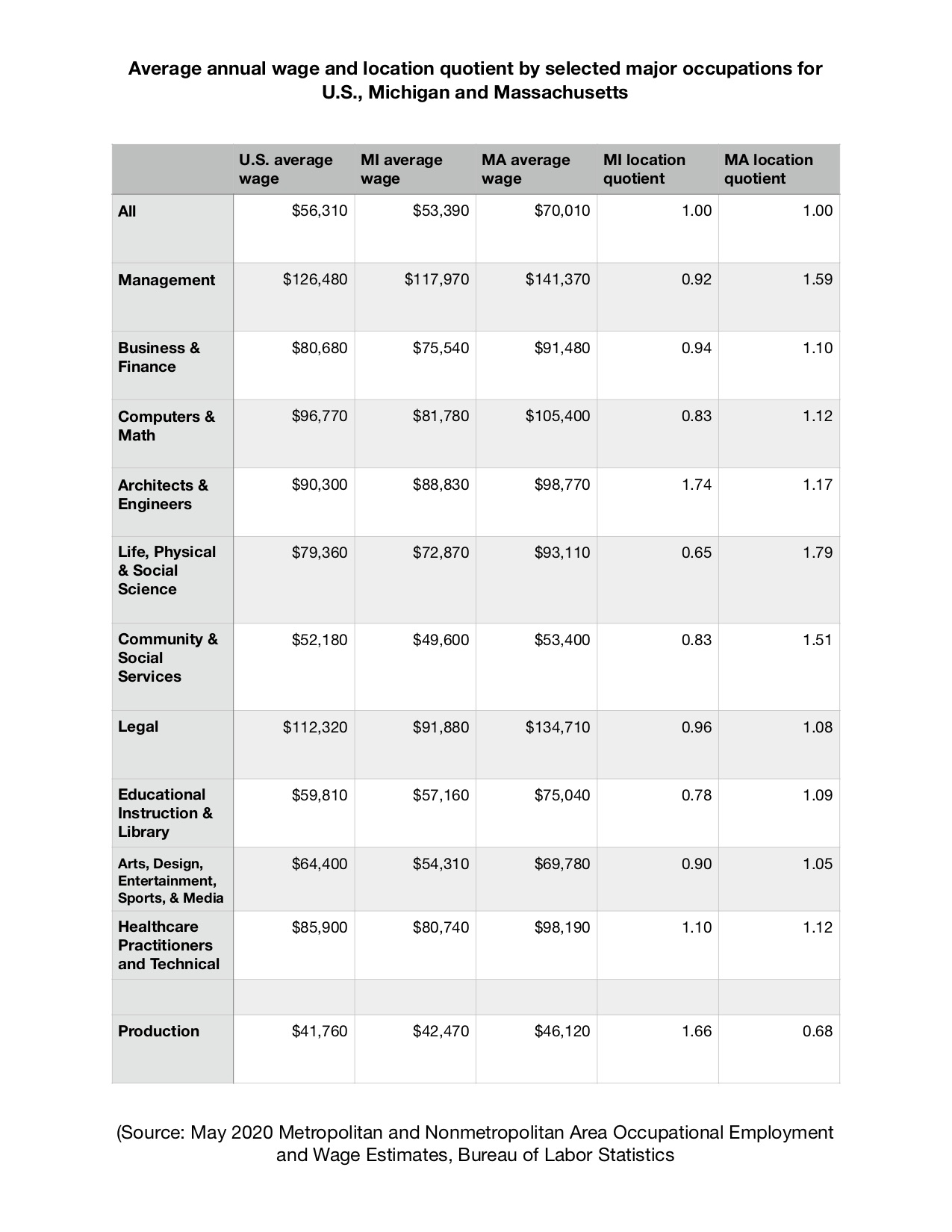
Terrific op ed in Crain’s Detroit Business by Glenn Stevens Jr., executive director of MICHauto and Britany Affolter-Caine, executive director of Michigan’s University Research Corridor. They write:
The most successful strategy to ensure Michigan’s long-term competitiveness and economic prosperity is to increase the number of workers with college degrees and with digital skills in professions at all levels and across all industries in Michigan, while making our communities attractive places to live and work.
… Michigan won’t be the prosperous state we envision together without these deeper and more long-term investments. Short-term incentives, while important in the moment, are not going to be enough to get us to where we need to be. Pursuing manufacturing jobs is important, but Michigan also must compete for knowledge-based jobs, which are the ones that are growing in today’s economy. To win knowledge-based jobs, we need to re-invest in higher education, move more university discoveries to market, increase people trained in high-tech at all levels, retain them, and invest in our communities so they are attractive places to live, work and play.
Exactly! As we have detailed, incentives to retain and attract manufacturing jobs cannot be the core strategy to return Michigan to high-prosperity. Big incentives are the icing on the cake, not the foundation of recreating a Michigan economy with a broad middle class. That is because, as Glenn and Britany note, knowledge-based occupations are now the growing, high-wage occupations.
As we have documented Michigan has a two-tier labor market: one tier of occupations where fewer than 10 percent of the jobs require a B.A. and a preponderance of jobs pay below what it takes to be middle class; and a second tier for occupations where more than 65 percent of the jobs require a B.A. and a preponderance of jobs pay more than what is required to be middle class.
The high-wage occupations are: • Architecture and Engineering • Arts, Design, Entertainment, Sports, and Media • Business and Financial Operations • Community and Social Service • Computer and Mathematical • Educational Instruction and Library • Healthcare Practitioners and Technical • Legal; • Life, Physical, and Social Science and • Management.
Combined these knowledge-based occupations account for 33.7 percent of the nation’s payroll jobs in 2020. Up from 28.1 percent in 2000. By contrast production (blue collar factory) jobs have declined from 9.6 percent of the nation’s payroll jobs in 2000 to 6.1 percent in 2020.
The high education attainment/high-wage occupations are 32.8 percent of Michigan’s payroll jobs. By comparison they are 42.3 percent of Massachusetts’ payroll jobs. Massachusetts is the prototypical high-prosperity/high knowledge-based economy state: second in per capita income and first in the proportion of adults with a B.A. or more.
The table at the bottom of this post details the annual average wage for the ten high education attainment major occupations plus production for the U.S., Michigan and Massachusetts. And the location quotient for those occupations for Michigan and Massachusetts.
(The location quotient is the ratio of the area concentration of occupational employment to the national average concentration. A location quotient greater than one indicates the occupation has a higher share of employment than average, and a location quotient less than one indicates the occupation is less prevalent in the area than average.)
Nationally the ten knowledge-based major occupations, with the exception of Community and Social Services, have average wages above the average for all jobs. Most substantially above. Production has an average wage 25.9 percent below the average for all jobs.
As you can see in the table, the knowledge-based occupations are also high-wage in Michigan, although lower than the nation and even farther behind Massachusetts. That is particularly true for Computer and Mathematical jobs where the average wage in Michigan is $15,000 lower than the nation and more than $24,000 lower than in Massachusetts.
Just like the nation, production jobs in Michigan are below average wage jobs: more than $10,000 lower than the state average for all jobs and more than $13,000 below the national average for all jobs.
Michigan is under concentrated in employment compared to the nation in all the knowledge-base occupations except for Architecture and Engineering and Healthcare Practitioners and Technical. By contrast, Massachusetts is over concentrated in employment compared to the nation in all the knowledge-base occupations.
Michigan’s under concentration and lower average wage in these knowledge-base major occupations are a major reason why Michigan’s employment earnings (wages and employer paid benefits) per capita are 16.8 percent below the nation. In 2000 Michigan’s employment earnings per capita were one percent above the nation’s. By contrast Massachusetts’s employment earnings per capita are 37.8 percent above the nation’s.
As Glenn and Britany wrote, the data are clear: the path to recreating a high-prosperity Michigan is an economic development strategy focused on competing for high-wage/high-growth knowledge-based jobs.








